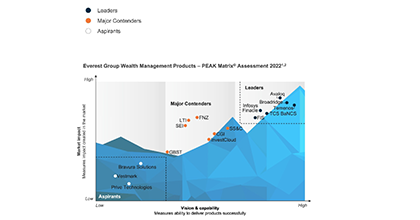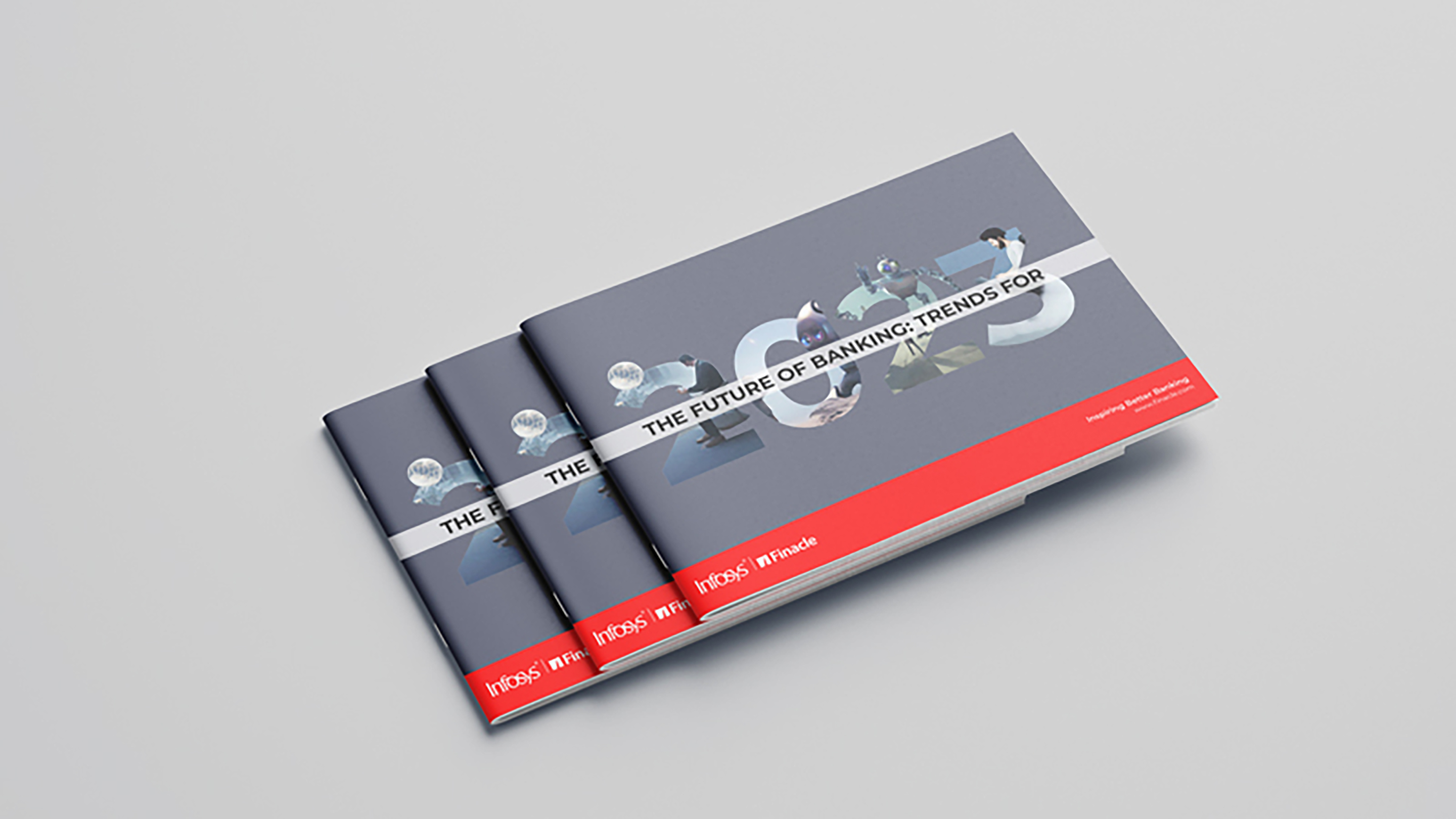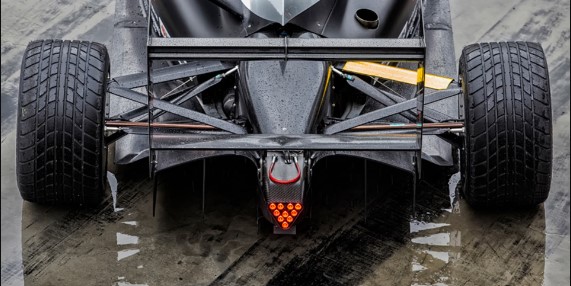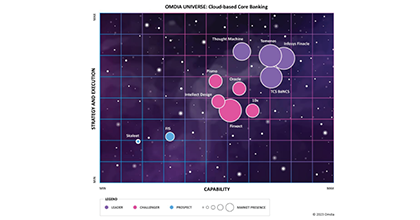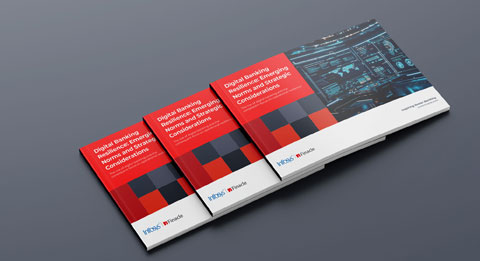-
![]() ESG in bankingESG-conscious banking should create new and future-proof value streams to build a sustainable and resilient business.Read More
ESG in bankingESG-conscious banking should create new and future-proof value streams to build a sustainable and resilient business.Read More -
![Everest Group PEAK Matri Everest Group PEAK Matri]() Everest Group PEAK MatrixA comprehensive solution delivering a full spectrum of wealth products as great experiences. It also improves the productivity of financial advisors and streamlRead More
Everest Group PEAK MatrixA comprehensive solution delivering a full spectrum of wealth products as great experiences. It also improves the productivity of financial advisors and streamlRead More -
![]() Subsidiary of an American Bank in IndonesiaFind out how a leading American bank adapts to a digitalized trade and supply chain finance operations as a part of its larger transformation by leveraging Finacle Trade Finance Solution Suite.Read More
Subsidiary of an American Bank in IndonesiaFind out how a leading American bank adapts to a digitalized trade and supply chain finance operations as a part of its larger transformation by leveraging Finacle Trade Finance Solution Suite.Read More
-
![]() Recomposing Banking: Leading the Digital ContinuumReport gives you a glimpse of the major areas where recomposing banking will create significant impact and value, Infosys Finacle has put together a report on..Read More
Recomposing Banking: Leading the Digital ContinuumReport gives you a glimpse of the major areas where recomposing banking will create significant impact and value, Infosys Finacle has put together a report on..Read More -
![]() Core Banking on Cloud: Navigating to the Fast LaneTake a deep dive into cloud-based core banking and explore the imperatives, opportunities and challenges, and the hallmarks of a robust solution.Read More
Core Banking on Cloud: Navigating to the Fast LaneTake a deep dive into cloud-based core banking and explore the imperatives, opportunities and challenges, and the hallmarks of a robust solution.Read More -
![]() Embracing Payments ComposabilityA step-by-step guide for maximizing Real Time Payment opportunities by embracing Payments Composability...Read More
Embracing Payments ComposabilityA step-by-step guide for maximizing Real Time Payment opportunities by embracing Payments Composability...Read More
-
![]() Shaping Banking’s Next: Banking Technology Trends for 2025 and BeyondThe banking industry has been balancing disruption and opportunity for several years now, and the pace of change shows no signs of slowing as we move into 2025 and beyond.Read More
Shaping Banking’s Next: Banking Technology Trends for 2025 and BeyondThe banking industry has been balancing disruption and opportunity for several years now, and the pace of change shows no signs of slowing as we move into 2025 and beyond.Read More -
![]() Virtual Accounts 2.0: Surpass Conventional Cash Management and Unlock Next-Gen PossibilitiesVirtual Account Management was a groundbreaking shift in the banking landscape, revolutionising use cases like cash concentration, pooling, centralised treasury management, and in-house banking (POBO, ROBO, COBO)Read More
Virtual Accounts 2.0: Surpass Conventional Cash Management and Unlock Next-Gen PossibilitiesVirtual Account Management was a groundbreaking shift in the banking landscape, revolutionising use cases like cash concentration, pooling, centralised treasury management, and in-house banking (POBO, ROBO, COBO)Read More -
![]() Unlocking Hybrid CloudAs banks push forward with their digital transformation agenda, cloud serves as a pivotal enabler. Each bank, at varying stages of adoption, crafts its unique path, dictated by context, regulations, and risk appetite.Read More
Unlocking Hybrid CloudAs banks push forward with their digital transformation agenda, cloud serves as a pivotal enabler. Each bank, at varying stages of adoption, crafts its unique path, dictated by context, regulations, and risk appetite.Read More
-
![]() Banking on CloudThis report from Infosys Finacle delves into the need for accelerating cloud adoption, highlights the current state of the industry, and puts forth key recommenRead More
Banking on CloudThis report from Infosys Finacle delves into the need for accelerating cloud adoption, highlights the current state of the industry, and puts forth key recommenRead More -
![]() Omdia Universe | Cloud-based Core BankingIn the report, Omdia highlights the following key capabilities of leading cloud-based core banking providers:Read more
Omdia Universe | Cloud-based Core BankingIn the report, Omdia highlights the following key capabilities of leading cloud-based core banking providers:Read more
-
![]() Emirates NBDEmirates NBD consolidates its operations on a single version for scalability, agility, and standardization.Read More
Emirates NBDEmirates NBD consolidates its operations on a single version for scalability, agility, and standardization.Read More -
![]() A Global Top 5 BankDiscover how a global top 5 bank headquartered in the US accelerated payments transformation.Read More
A Global Top 5 BankDiscover how a global top 5 bank headquartered in the US accelerated payments transformation.Read More -
![]() Union Bank of IndiaUnion Bank of India launches Union Virtual Connect (UVConn) by leveraging WhatsApp to provide customers personalized banking services.Read More
Union Bank of IndiaUnion Bank of India launches Union Virtual Connect (UVConn) by leveraging WhatsApp to provide customers personalized banking services.Read More

Tracking Mobile Banking Innovation – II
Blogs
The emerging markets have the numbers and the ambition, but innovation is not necessarily or innately indigenous. That was where I signed off in my last post, so let me pick it up from there.
What works for the developing can also work for the developed. Emerging markets typically innovate around constraints – like weak infrastructure or low literacy for example – that may not be applicable to more mature markets. The innovation process in emerging markets is often defined by a search for fundamental utility rather than indisputable excellence, which has driven frugal innovation in many of these countries.
But though the approach to innovation may be starkly different, it does not automatically preclude solutions from crossing the developmental divide. Case in point, Kenyan success story, mPESA, which can now be found even in some developed markets. Or consider YouTube’s plans to enable offline playback in order to circumvent the problems of limited mobile bandwidth and access in India. Now that’s an idea that should find resonance even in bandwidth-rich countries.
But having said that, I must add that emerging markets are also evolving up the innovation value chain. Brazil, for instance, has taken a two-track approach to banking innovation where one track caters to the affluent classes with ‘developed world’ products and the other focuses on the needs of the underbanked.
So quality or caliber of innovation is not necessarily the most efficient, or even the most equitable, approach to map an innovation to its provenance. Why, Malaysia’s Maybank has managed to completely mobilize account origination even as many banks in developed markets are still grappling with the complexities.
My view, therefore, is that every mobile banking innovation is a winner and disruptive innovations with a global resonance will emerge from markets at all levels of maturity and sophistication. For instance, any hardware innovations that originate from developed economies may well be adapted to serve certain needs that are specific to emerging markets.
But emerging markets do seem to be developing into a hotbed of mobile banking innovation. Apart from their inherent growth potential, technology vendors, telecom providers and financial institutions from around the world are also increasingly looking at these markets to establish and develop global innovation hubs. In many of these markets, ‘mobile first’ banking is not merely seen as an evolution of traditional banking but also as the easiest and quickest route to take formal banking to the un- and under-banked masses. Now that is a situation ripe with the possibility of fostering innovations that could easily find application across the globe. Meanwhile ambitious startups in the established innovation ecosystems of the developing world are working on the next big idea that will resonate globally. At the end of the day, it all comes down to the power of an idea and the versatility of its applications. Geography is just incidental.


©2025 -Edgeverve Systems Limited | All rights reserved

